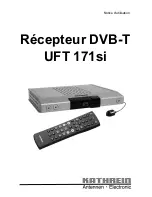
MDS 05-4846A01, Rev. F
SD Series Technical Manual
45
Remote must have a unique Unit Address, however, which is set
on the Diagnostic Settings screen (see below). A Store and For-
ward device is a radio designated to retransmit data to/from an
outlying Remote (see SAF Network, below).
•
SAF Network
—(AP Only) Selects whether or not a Store and For-
ward radio is present in the network (
True
), or disabled (
False
).
Store and Forward allows extending the coverage area of a net-
work beyond the primary “footprint” of the system. This can be
used to link outlying Remotes (or Remotes blocked by terrain or
other obstructions) into the network. A detailed discussion on
using Store and Forward is provided below.
•
Repeater Network
—(AP Only) This setting must be enabled if the
RF network contains a repeater station, or communications will
not work. Remotes automatically learn this setting from the AP.
•
Retry Count
—If a message is not acknowledged after transmission
it will be resent. This value controls how many times the radio
attempts to resend the message before discarding it.
•
Time-to-Live (s)
—When a message arrives from the payload inter-
face(s) it is time-stamped and queued for radio transmission. If
the radio cannot transmit the message before the Time-to-live
(TTL) value, the message is discarded. This helps prevent stale or
old data from being sent over the air.
Store and Forward Operation
Store and forward (SAF) operation extends a wireless network’s cov-
erage area by electing a device or devices to store data and forward it to
a unit (or units) beyond the reach of the primary coverage area. Conven-
tional RF repeaters receive and transmit data simultaneously. They are
effective at increasing range with low latency, but they are more expen-
sive, have high power consumption, and require more complex installa-
tion. SD SAF-designated units act as smart single radio packet repeaters.
The SAF feature provides a simple, low cost alternative to range exten-
sion when a traditional repeater isn’t warranted.
Figure 26 depicts a typical single unit SAF network. The SD network
supports a
single
SAF hop. Chained SAF hops are not allowed. How-
ever, multiple SAF radios are supported provided their RF coverage
areas do not overlap, as this would create radio interference and severely
reduce throughput. SAF will work in conjunction with SD repeater
assemblies to provide even more extended range.
NOTE:
Remote radios being served by a Store-and-Forward unit must
have their TX/RX frequencies set to match those of the
AP/Master station. This allows communication with the SAF
radio, which uses standard Remote TX/RX frequencies.
















































